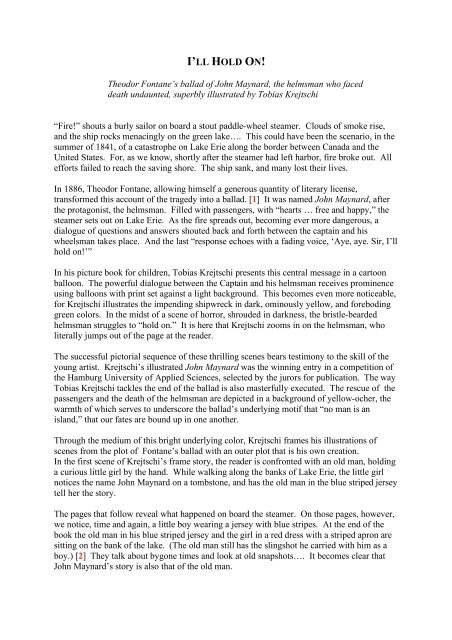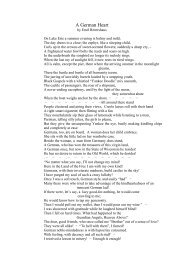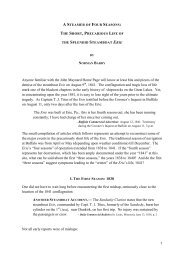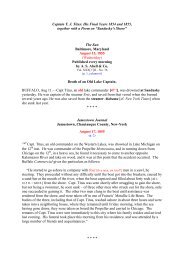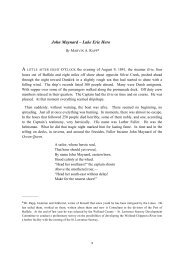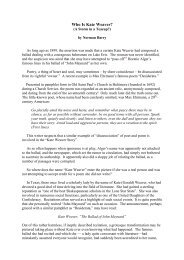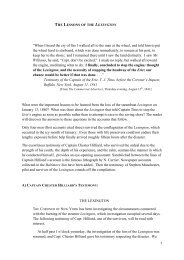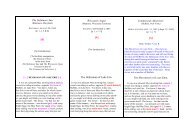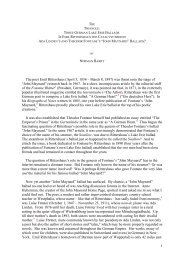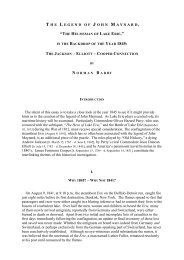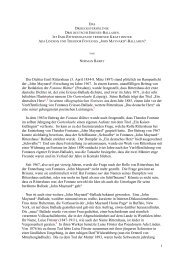An English translation by Norman Barry of the book review in Die ...
An English translation by Norman Barry of the book review in Die ...
An English translation by Norman Barry of the book review in Die ...
Create successful ePaper yourself
Turn your PDF publications into a flip-book with our unique Google optimized e-Paper software.
I’LL HOLD ON!<br />
Theodor Fontane’s ballad <strong>of</strong> John Maynard, <strong>the</strong> helmsman who faced<br />
death undaunted, superbly illustrated <strong>by</strong> Tobias Krejtschi<br />
“Fire!” shouts a burly sailor on board a stout paddle-wheel steamer. Clouds <strong>of</strong> smoke rise,<br />
and <strong>the</strong> ship rocks menac<strong>in</strong>gly on <strong>the</strong> green lake…. This could have been <strong>the</strong> scenario, <strong>in</strong> <strong>the</strong><br />
summer <strong>of</strong> 1841, <strong>of</strong> a catastrophe on Lake Erie along <strong>the</strong> border between Canada and <strong>the</strong><br />
United States. For, as we know, shortly after <strong>the</strong> steamer had left harbor, fire broke out. All<br />
efforts failed to reach <strong>the</strong> sav<strong>in</strong>g shore. The ship sank, and many lost <strong>the</strong>ir lives.<br />
In 1886, Theodor Fontane, allow<strong>in</strong>g himself a generous quantity <strong>of</strong> literary license,<br />
transformed this account <strong>of</strong> <strong>the</strong> tragedy <strong>in</strong>to a ballad. [1] It was named John Maynard, after<br />
<strong>the</strong> protagonist, <strong>the</strong> helmsman. Filled with passengers, with “hearts … free and happy,” <strong>the</strong><br />
steamer sets out on Lake Erie. As <strong>the</strong> fire spreads out, becom<strong>in</strong>g ever more dangerous, a<br />
dialogue <strong>of</strong> questions and answers shouted back and forth between <strong>the</strong> capta<strong>in</strong> and his<br />
wheelsman takes place. <strong>An</strong>d <strong>the</strong> last “response echoes with a fad<strong>in</strong>g voice, ‘Aye, aye. Sir, I’ll<br />
hold on!’”<br />
In his picture <strong>book</strong> for children, Tobias Krejtschi presents this central message <strong>in</strong> a cartoon<br />
balloon. The powerful dialogue between <strong>the</strong> Capta<strong>in</strong> and his helmsman receives prom<strong>in</strong>ence<br />
us<strong>in</strong>g balloons with pr<strong>in</strong>t set aga<strong>in</strong>st a light background. This becomes even more noticeable,<br />
for Krejtschi illustrates <strong>the</strong> impend<strong>in</strong>g shipwreck <strong>in</strong> dark, om<strong>in</strong>ously yellow, and forebod<strong>in</strong>g<br />
green colors. In <strong>the</strong> midst <strong>of</strong> a scene <strong>of</strong> horror, shrouded <strong>in</strong> darkness, <strong>the</strong> bristle-bearded<br />
helmsman struggles to “hold on.” It is here that Krejtschi zooms <strong>in</strong> on <strong>the</strong> helmsman, who<br />
literally jumps out <strong>of</strong> <strong>the</strong> page at <strong>the</strong> reader.<br />
The successful pictorial sequence <strong>of</strong> <strong>the</strong>se thrill<strong>in</strong>g scenes bears testimony to <strong>the</strong> skill <strong>of</strong> <strong>the</strong><br />
young artist. Krejtschi’s illustrated John Maynard was <strong>the</strong> w<strong>in</strong>n<strong>in</strong>g entry <strong>in</strong> a competition <strong>of</strong><br />
<strong>the</strong> Hamburg University <strong>of</strong> Applied Sciences, selected <strong>by</strong> <strong>the</strong> jurors for publication. The way<br />
Tobias Krejtschi tackles <strong>the</strong> end <strong>of</strong> <strong>the</strong> ballad is also masterfully executed. The rescue <strong>of</strong> <strong>the</strong><br />
passengers and <strong>the</strong> death <strong>of</strong> <strong>the</strong> helmsman are depicted <strong>in</strong> a background <strong>of</strong> yellow-ocher, <strong>the</strong><br />
warmth <strong>of</strong> which serves to underscore <strong>the</strong> ballad’s underly<strong>in</strong>g motif that “no man is an<br />
island,” that our fates are bound up <strong>in</strong> one ano<strong>the</strong>r.<br />
Through <strong>the</strong> medium <strong>of</strong> this bright underly<strong>in</strong>g color, Krejtschi frames his illustrations <strong>of</strong><br />
scenes from <strong>the</strong> plot <strong>of</strong> Fontane’s ballad with an outer plot that is his own creation.<br />
In <strong>the</strong> first scene <strong>of</strong> Krejtschi’s frame story, <strong>the</strong> reader is confronted with an old man, hold<strong>in</strong>g<br />
a curious little girl <strong>by</strong> <strong>the</strong> hand. While walk<strong>in</strong>g along <strong>the</strong> banks <strong>of</strong> Lake Erie, <strong>the</strong> little girl<br />
notices <strong>the</strong> name John Maynard on a tombstone, and has <strong>the</strong> old man <strong>in</strong> <strong>the</strong> blue striped jersey<br />
tell her <strong>the</strong> story.<br />
The pages that follow reveal what happened on board <strong>the</strong> steamer. On those pages, however,<br />
we notice, time and aga<strong>in</strong>, a little boy wear<strong>in</strong>g a jersey with blue stripes. At <strong>the</strong> end <strong>of</strong> <strong>the</strong><br />
<strong>book</strong> <strong>the</strong> old man <strong>in</strong> his blue striped jersey and <strong>the</strong> girl <strong>in</strong> a red dress with a striped apron are<br />
sitt<strong>in</strong>g on <strong>the</strong> bank <strong>of</strong> <strong>the</strong> lake. (The old man still has <strong>the</strong> sl<strong>in</strong>gshot he carried with him as a<br />
boy.) [2] They talk about <strong>by</strong>gone times and look at old snapshots…. It becomes clear that<br />
John Maynard’s story is also that <strong>of</strong> <strong>the</strong> old man.
A tale which can still hold us spellbound –and a thrill<strong>in</strong>g new achievement <strong>in</strong> illustrated<br />
<strong>book</strong>s for children.<br />
Elisabeth Hohmeister<br />
<strong>Die</strong> Zeit, No. 48, November 20, 2008<br />
Theodor Fontane/Tobias Krejtschi (III.):<br />
John Maynard<br />
(Berl<strong>in</strong>, Germany: K<strong>in</strong>dermann Publish<strong>in</strong>g Company, 2008); 24 pages,<br />
14.50 euros<br />
(recommended for children six years <strong>of</strong> age or<br />
older)<br />
ISBN 978-3-934029-31-6<br />
The <strong>book</strong> can be ordered through www.Amazon.de .<br />
Biographical <strong>in</strong>formation on (and a very good picture <strong>of</strong>) Tobias Krejtschi can<br />
be found at <strong>the</strong> follow<strong>in</strong>g site:<br />
http://hammer.txt.de/Hammer/TXTSIAutor/2018<br />
8-Tobias-Krejtschi<br />
The K<strong>in</strong>dermann series <strong>of</strong> children’s <strong>book</strong>s entitled “Poesie für K<strong>in</strong>der”<br />
[Poetry for Children] is one <strong>of</strong> <strong>the</strong> best <strong>in</strong> Germany. O<strong>the</strong>r poetic works for<br />
children <strong>by</strong> this highly reputable publish<strong>in</strong>g house may be found at:<br />
http://www.k<strong>in</strong>dermannverlag.de/poesie-fuerk<strong>in</strong>der.htm<br />
<strong>An</strong>notations:<br />
1) The abridged 1860 version <strong>of</strong> John Maynard <strong>by</strong> John Bartholomew Gough and <strong>the</strong> orig<strong>in</strong>al<br />
anonymous 1845 version <strong>of</strong> “The Helmsman <strong>of</strong> Lake Erie” have been overlooked. Fontane<br />
did not himself create <strong>the</strong> legend <strong>of</strong> John Maynard, but based his ballad on Gough’s<br />
render<strong>in</strong>g, which was a modified and abridged version <strong>of</strong> <strong>the</strong> orig<strong>in</strong>al “Helmsman <strong>of</strong> Lake<br />
Erie,” first published on August 30, 1845, <strong>in</strong> <strong>the</strong> Baltimore Sun.<br />
The question whe<strong>the</strong>r Fontane might <strong>in</strong>deed have read about <strong>the</strong> Erie tragedy has received<br />
new impulses from <strong>the</strong> German article on “The Loss <strong>of</strong> <strong>the</strong> Erie” <strong>in</strong> <strong>the</strong> Gewerbe-Blatt für<br />
Sachsen, k<strong>in</strong>dly provided <strong>by</strong> Mr. Lutz Weide <strong>in</strong> January 2009. Cf. <strong>Norman</strong> <strong>Barry</strong>, “<strong>An</strong><br />
Investigation <strong>of</strong> American Source Material Used <strong>by</strong> <strong>the</strong> Gewerbe-Blatt für Sachsen <strong>in</strong><br />
Leipzig Germany on October 8 th , 1841, under <strong>the</strong> Head<strong>in</strong>g “Loss <strong>of</strong> <strong>the</strong> Steamboat Erie:”<br />
http://homepage.mac.com/joel_huberman/JohnMaynard/SCAEssay.pdf , p. 19; and<br />
Schlussfolgerung der Untersuchung des Artikels „Der Untergang des Dampfbootes Erie“ <strong>in</strong><br />
dem Gewerbe-Blatt für Sachsen vom 8. Oktober 1841:<br />
http://homepage.mac.com/joel_huberman/JohnMaynard/Zus.pdf , p. 2.<br />
Fontane’s steamer is <strong>the</strong> Swallow. Krejtschi depicts an actual swallow on four separate pages<br />
– no doubt represent<strong>in</strong>g <strong>the</strong> spirit <strong>of</strong> <strong>the</strong> Swallow and <strong>of</strong> John Maynard, that still live on <strong>in</strong> our<br />
hearts and m<strong>in</strong>ds.<br />
2) <strong>An</strong> observation added <strong>by</strong> <strong>the</strong> translator.<br />
Translated <strong>by</strong> <strong>Norman</strong> <strong>Barry</strong>, Dec. 14, 2008,<br />
<strong>An</strong>notation #1: updated March 2009


